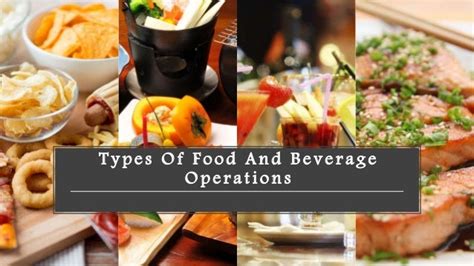The Complete Guide to Food and Beverage Operations
The food and beverage (F&B) industry is a dynamic and competitive sector, demanding meticulous planning and execution. This comprehensive guide delves into the essential aspects of successful F&B operations, covering everything from menu planning to staff management. Whether you're launching a new restaurant, managing an existing establishment, or simply curious about the inner workings of the industry, this guide will provide invaluable insights.
I. Menu Engineering & Development
A well-engineered menu is the cornerstone of any successful F&B operation. It's not just about listing dishes; it's about crafting a profitable and appealing culinary journey for your customers.
A. Menu Planning Strategies
- Target Audience: Identify your ideal customer. Understanding their preferences, dietary restrictions, and spending habits is crucial for menu design.
- Market Research: Analyze your competition. What are their strengths and weaknesses? What menu items are popular? What price points are they charging?
- Cost Analysis: Thoroughly calculate the cost of goods sold (COGS) for each item. This is essential for determining profitability.
- Menu Pricing: Strategically price your menu items to achieve a healthy profit margin while remaining competitive. Consider using techniques like price anchoring and value-based pricing.
- Menu Design & Layout: Create a visually appealing and easy-to-navigate menu. Strategic placement of high-profit items can significantly impact sales.
B. Developing Unique Dishes
- Creativity & Innovation: Offer unique and exciting dishes that set you apart from the competition. Consider seasonal ingredients and culinary trends.
- Recipe Testing & Refinement: Thoroughly test and refine all recipes before launching them on the menu. Get feedback from staff and taste testers.
- Recipe Standardization: Document your recipes precisely to ensure consistency and quality across all preparations.
II. Kitchen Management & Operations
Efficient kitchen management is vital for maintaining high quality, consistency, and profitability.
A. Kitchen Workflow Optimization
- Layout & Design: Ensure your kitchen layout is efficient and maximizes workflow. Minimize unnecessary movement and bottlenecks.
- Equipment Maintenance: Regularly maintain and clean kitchen equipment to prevent breakdowns and ensure optimal performance.
- Inventory Management: Implement an effective inventory management system to minimize food waste and control costs. Implement a FIFO (First In, First Out) system.
- Food Safety & Hygiene: Strictly adhere to food safety regulations and maintain the highest standards of hygiene. Regular staff training is crucial.
B. Staff Training & Development
- Cross-Training: Train staff in multiple kitchen roles to enhance flexibility and efficiency.
- Ongoing Professional Development: Encourage your staff to continuously improve their skills and knowledge.
III. Front-of-House Operations & Customer Service
The front-of-house experience directly impacts customer satisfaction and loyalty. Excellent service is paramount.
A. Customer Service Excellence
- Staff Training: Provide thorough training on customer service skills, including communication, conflict resolution, and handling complaints.
- Table Management: Implement an efficient table management system to minimize wait times and optimize seating arrangements.
- Order Taking & Service: Ensure orders are taken accurately and served promptly and efficiently.
- Handling Complaints: Develop strategies for addressing customer complaints professionally and effectively.
B. Point of Sale (POS) Systems
- Efficiency & Accuracy: Use a reliable POS system to streamline order processing, payment processing, and inventory management.
- Data Analysis: Utilize POS data to track sales trends, popular menu items, and customer preferences. This valuable data helps inform future menu decisions and marketing strategies.
IV. Marketing & Sales Strategies
Effective marketing is essential for attracting customers and building a strong brand.
A. Brand Building & Positioning
- Unique Selling Proposition (USP): Identify and highlight your unique selling proposition – what makes your establishment stand out?
- Consistent Branding: Maintain consistent branding across all platforms, from your menu to your website and social media.
B. Marketing Channels
- Social Media Marketing: Engage with customers on social media platforms to build brand awareness and drive sales.
- Online Ordering & Delivery: Offer online ordering and delivery services to expand your reach and cater to modern consumer preferences.
- Local Partnerships: Collaborate with local businesses and community organizations to increase visibility and build relationships.
This comprehensive guide provides a solid foundation for understanding and managing food and beverage operations. Remember that success requires constant adaptation, innovation, and a commitment to delivering exceptional customer experiences. By focusing on these key areas, you can build a thriving and profitable F&B business.
